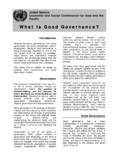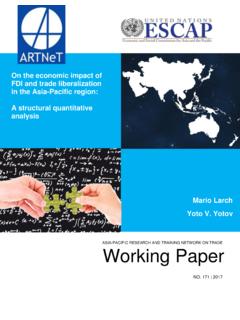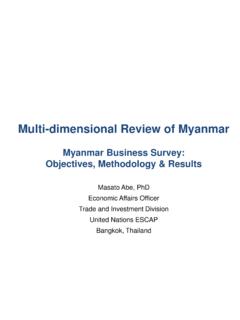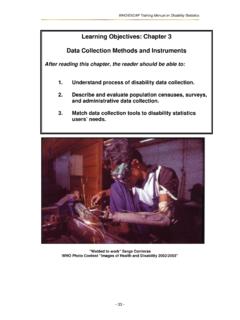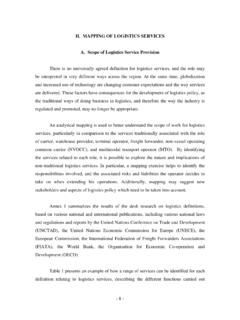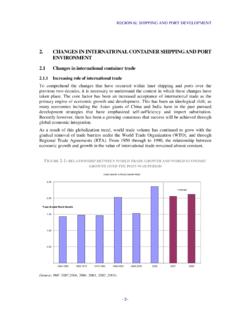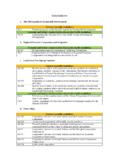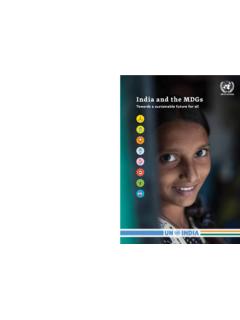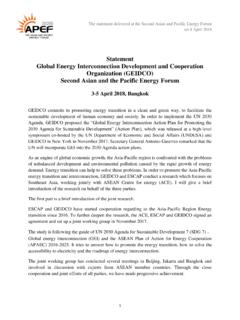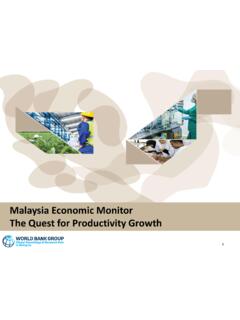Transcription of Enabling Entrepreneurship for Women’s Economic …
1 IIIACKNOWLEDGEMENTSThis publication is the product of the joint ESCAP and Goldman Sachs 10,000 Women initiative aimed at fostering women s Entrepreneurship in Asia and the Pacific by strengthening the existing knowledge base and the capacities of ESCAP Secretariat is grateful to Goldman Sachs 10,000 Women for its input and contri-bution to this publication, providing invaluable support in the implementation of the joint regional publication benefited from the work of the following national research partners that conducted the country studies and primary surveys: National Entrepreneurship Research Centre, Tsinghua University (China); International Centre for Entrepreneurship and Career Development and the Federation of Indian Chambers of Commerce and Industry Ladies Organization (India); Global Entrepreneurship Program Indonesia (Indonesia); and Universiti Tun Abdul Razak ( malaysia ).
2 The ESCAP secretariat gratefully acknowledges the contribution made by national partners in the organization of the national consultations to enhance policy support for women s Entrepreneurship : All-China Women s Federation (China), Federation of Indian Chambers of Commerce and Industry Ladies Organization (India), Ministry of Women s Empowerment and Child Protection (Indonesia), and Ministry of Women, Family and Community Development ( malaysia ).This publication was made possible by the contribution of many organizations and individuals, including women entrepreneurs, policymakers, business leaders and academics, who shared their insights on measures to create an Enabling environment for women s Economic empowerment through cover and layout of the publication were designed by Daniel Feary.
3 IVLIST OF ACRONYMSAPEC Asia-Pacific Economic CooperationESCAP Economic and Social Commission for Asia and the PacificFLO Federation of Indian Chambers of Commerce and Industry Ladies OrganizationGEDI Global Entrepreneurship and Development IndexGEM Global Entrepreneurship MonitorGEPI Global Entrepreneurship Program IndonesiaICECD International Centre for Entrepreneurship and Career DevelopmentICT Information and Communication TechnologiesOECD Organization for Economic Cooperation and DevelopmentMSME Micro, Small and Medium-sized EnterprisesSME Small and Medium-Sized EnterprisesUNIRAZAK Universiti Tun Abdul Razak, Malaysia1 CONTENTSCHAPTER PAGE Acknowledgements iii List of Acronyms iv Executive Summary 21 Introduction 42 The Study 83 Policy development, coordination and implementation 124 Access to finance and credit 245 Capacity and time 336 Sociocultural factors 437 Conclusions and recommendations 48 References 54 Executive Summary23 Enabling Entrepreneurship for Women s Economic Empowerment in Asia and the Pacific presents the key findings of the ESCAP-Goldman Sachs programme.
4 The research findings highlight context-specific experiences and shared challenges for women s Entrepreneurship that resonate across the Asia-Pacific publication begins with an introduction that highlights the growing role played by wom-en entrepreneurs in Asian and Pacific econo-mies. The introduction is followed by an outline of the ESCAP and Goldman Sachs 10,000 Women study that forms the basis of the publication. In this context, brief profiles provide the policy context, key data and trends for women s entre-preneurship in the study s four focus countries: China, India, Indonesia and 3 to 6 document the common barriers that limit opportunities for women to establish, manage and grow an enterprise. Barriers are considered in four areas that are critical deter-minants of the entrepreneurial environment, namely (a) policy development, coordination and implementation, (b) access to finance and credit, (c) capacity development and (d) social and cultural publication concludes with recommenda-tions for gender-responsive policy approaches that support women s Economic empowerment through Entrepreneurship in China, India, Indonesia and malaysia , with application across Asia and and the Pacific is considered the engine of global growth , as it is home to six of the world s top ten fastest growing economies.
5 Yet, this growth is hampered by inequalities across the Asia-Pacific region, in particular gender inequalities. Hindrances, whether structural or social, limit women s Economic participation, denying communities and countries of greater socioeconomic growth that is of benefit to all elements of society. Entrepreneurship is a key means of redressing this inequality and the associated impediments to equitable, inclusive and sustainable the potential of, and the chal-lenges for, women s Entrepreneurship across the Asia-Pacific region, the Economic and Social Commission for Asia and the Pacific (ESCAP) and Goldman Sachs 10,000 Women launched a joint programme to promote Enabling policy and legal environments for women s Entrepreneurship in four coun-tries in Asia and the Pacific: China, India, Indonesia and programme involved partnerships with leading national research institutions in each of the four countries.
6 The partnerships enabled in-depth analysis of national contexts for women s Entrepreneurship through research on the circumstances of, barriers to and strategies for successful women s Entrepreneurship . Introduction1 CHAPTER45 Philippines, while established business owners remained predominantly male (66 per cent), in 2007, some 69 per cent of nascent business owners and 51 per cent of new business owners were Such data highlight the interest and capacity of women to engage in Entrepreneurship , which has the two-fold eff ect of empowering the women themselves and contributing to the equitable and inclusive Economic growth of their countries. Restrictions on women s participation in the labour force, whether through wage employment or Entrepreneurship , come at the cost of US$ 89 billion per many forms of structural and social barriers to their Economic engagement that women encounter in the Asia-Pacifi c region from access to credit to opportuni-ties to acquire skills need to be addressed in order to realize the potential contribution of women to the equitable and inclusive growth of their the national economies of Asia and the Pacifi c, entrepreneurs are critical drivers of growth through innovation and job cre-ation.
7 Micro, small and medium enterprises (MSMEs) employ between 60 and 80 per cent of the national workforces in more than ten countries in Asia and the Pacifi c, including China, Japan, Sri Lanka and According to the Asia-Pacific Economic Cooperation, small and medium enterprises account for 90 per cent of businesses and over 60 per cent of employment in countries of the Pacifi c Rim. Between 2000 and 2009, MSMEs in East Asia and the Pacifi c grew by eight per cent, which is two per cent above the global entrepreneurs have been critical contributors to the Economic growth in Asia and the Pacifi c. Women entrepreneurs are increasing in number. For example, between 2002 and 2007, women-owned small and medium enterprises in Indonesia grew by more than eight per In the 1 World Bank and International Finance Corporation, MSME Country Indicators Database: +Markets/msme+fi nance/sme+ Kushnir, K.
8 , Mirmulstein and R. Ramalho, Micro, Small, and Medium Enterprises Around the World: How Many Are There, and What Affects the Count? , in MSME Country Indicators 2010 (Washington , World Bank and International Finance Corporation, 2010).3 MasterCard Worldwide Insights, Women-owned SMEs in Asia/Pacifi c, Middle East and Africa: An Assessment of the Business Environment (2010), p. Madarang, I. and C. Habito, Philippine Report 2006-2007 (Global Entrepreneurship Monitor, 2007).5 ESCAP (2007). Economic and Social survey of Asia and the Pacifi c 2007: Surging Ahead in Uncertain Times, p. female and male labour force participation rates for India, Indonesia and Malaysia6100 percentINDIA267650528381 INDONESIAMALAYSIAFIGURE 17 With recognition of the importance of private enterprise to inclusive, equitable and sustainable Economic growth, and of inequalities in the Economic participation of women and men, governments in Asia and the Pacific have been reviewing, revising and initiating policies and legislation to enable women s inequalities in Economic activity are varied.
9 In terms of labour force participation rates, women s engagement in wage em-ployment and Entrepreneurship is distinctly lower than that of men, as indicated in Figure 1 for the countries of the the small and medium enterprises sector, women-owned enterprises are consistently smaller than those owned by men, as well as being concentrated in less profitable sec-tors. While not inherently less productive, women-owned enterprises are more likely to be unregistered micro-enterprises oper-ating in the home or on temporary premises, with fewer employees and limited capital for across the Asia-Pacific re-gion have recognized the role of small and medium enterprises in promoting national Economic growth, with associated formula-tion of national development strategies to promote the establishment and expansion of such enterprises.
10 Many countries in the region operate enterprise support schemes, combining state-sponsored programmes and private sector incentives to encourage the establishment of, and investment in, small and medium enterprises, by women and ILOSTAT, International Labour Organization Statistics Database, World Bank, World Development Report 2012: Gender Equality and Development (Washington , World Bank, 2012).The Study2 CHAPTER89In support of the government initiatives in Asia and the Pacific, and to promote women s Economic empowerment, ESCAP, in partnership with Goldman Sachs 10,000 Women, launched a regional pro-gramme in 2012 to promote an Enabling policy and legal environment for women s Entrepreneurship in four countries: China, India, Indonesia and study of women s Entrepreneurship in China, India, Indonesia and malaysia involved (a) national-level desk reviews of Entrepreneurship , (b) surveying women entrepreneurs in each of the four countries, (c) conducting individual interviews with selected women entrepreneurs, (d) hold-ing national level consultations with key stakeholders, and (e) convening a regional forum.
